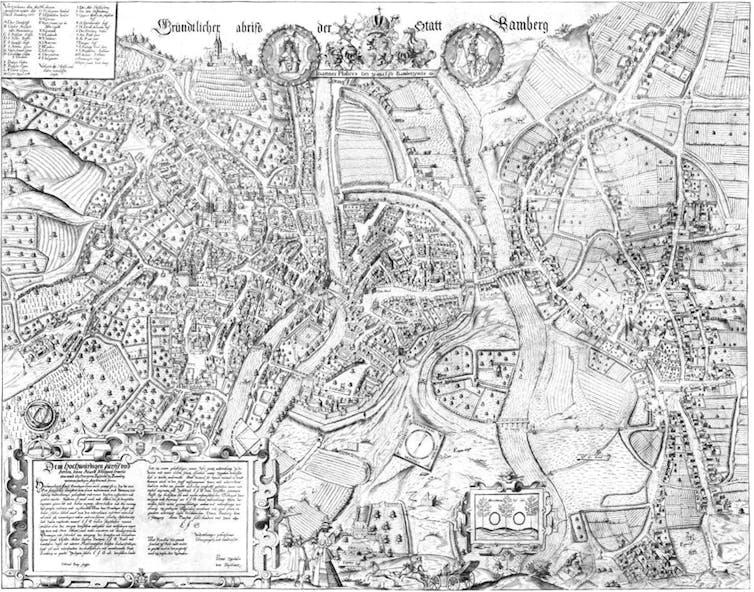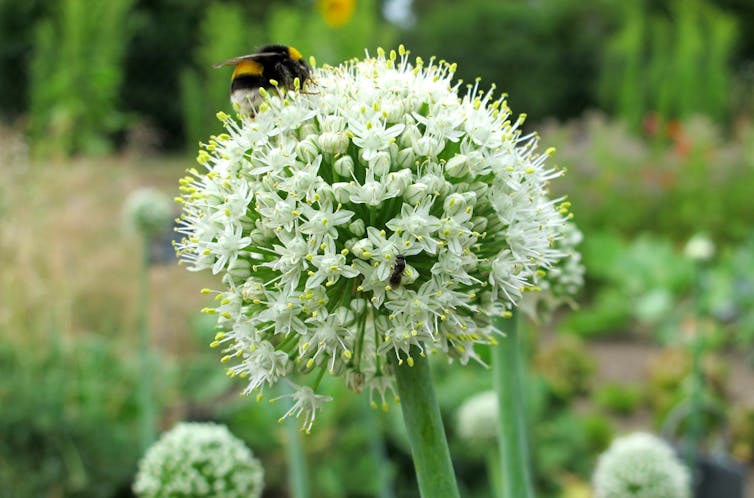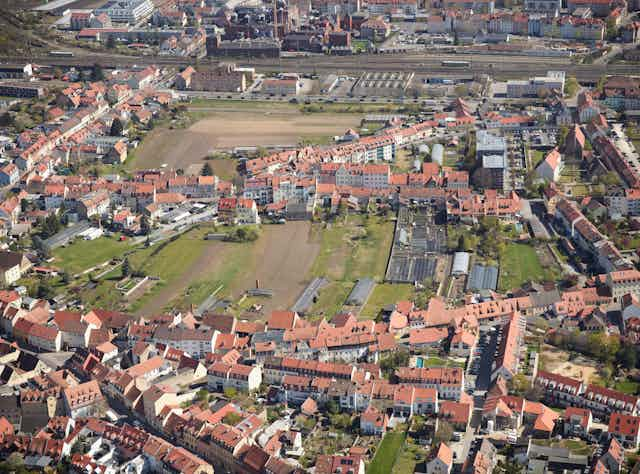In the middle of the Bavarian World Heritage City of Bamberg there is a hidden attraction waiting to be discovered: the Market Gardeners’ District (Untere Gärtnerei). Several hectares of gardeners’ land are encircled by densely built and distinctive small houses. The district is located within walking distance of the city’s cathedral and the Old Town Hall.
Gardeners have cultivated the area since the Middle Ages. At the time, horticulture was the city’s most important economic sector, supported by the Bamberg monasteries. The production and trade of seeds and vegetables flourished thanks to the region’s mild climate, the proximity to the river Regnitz as a transport route, and the city’s commercial diversity and vibrancy. The light, sandy soils in the alluvial plain of the Regnitz offered the best growing conditions, especially for the cultivation of root vegetables. The soil is enriched with humus in the uppermost layer, and starting from 1 metre down there is pure sand.
In the 16th and 17th centuries, the liquorice plant was the city’s most important crop and main source of income for gardeners. Long sought after as a medicinal plant and as a sweetener, it’s featured on the city’s oldest map, created by Petrus Zweidler in 1602.

When Bamburg got a railway station during industrialisation in 1844, fresh vegetables could also be delivered to more distant towns. Around 1900, at the height of the profession, 540 gardeners and their families grew vegetables, flowers and herbs in the Market Gardeners’ District.
The city thus enjoys a long tradition of urban gardening, with the knowledge of growing and harvesting crops as well as propagating seeds passed down from generation to generation. So valuable is the skill that it was included in the German inventory of Intangible Cultural Heritage in 2016.
Challenges for traditional land use
Unfortunately, horticulture has declined sharply in Bamberg in recent decades, with the number of commercial market gardens dropping to just 20 or 30 today. This is due to unfavourable competitive conditions linked to the spatial form of the Market Gardeners’ District: the small cultivation areas constrain mechanisation opportunities, irrigation costs are significantly higher than they would be in the countryside, and there are few parking spaces. As a result, large parts of the inner-city open space structures have fallen into disuse, despite the protection provided by the Bavarian Monument Protection Act.

Changing socio-cultural practices
As indicated, despite medieval origins and legal prescription, the commercial cultivation of the Market Gardeners’ District has suffered from declining gardener numbers to the extent that official concerns over its survival are expressed. To complicate matters, the gardeners do not share a single identity but are split between two historical fraternities, mirroring parish divisions. Even today, there is strong membership allegiance to the fraternity, while weak cooperation between them as well as scepticism about cooperation with “outsiders” go on.
[More than 80,000 readers look to The Conversation France’s newsletter for expert insights into the world’s most pressing issues. Sign up now]
The organisation in 2012 of the Bavarian State Garden Show in combination with funding through the National Investment Programme for World Heritage Sites have contributed to positive changes. The Bamberg Gardeners’ Interest Group was established to stimulate and consolidate closer cooperation between gardeners. In parallel, other new actor entered Bamberg’s system of urban horticulture:
The Bamberg Liquorice Society was formed in 2009 with the view of renewing the cultivation of the traditional crop. It ceased to be produced commercially in the mid-1960s, breaking a link that had existed for 500 years in Bamberg. The Liquorice Society’s products, including tea, are sold locally but are not competitive nationally.
The Heritage Garden, created in 2012, is an innovation intended to retain urban horticulture spaces. In this case, a plot left uncultivated after the retirement of a commercial gardener was rented and became a repository for over 30 distinctive local vegetable varieties that are ideally adapted to the local climate and soil. Supporters have unearthed old recipes which list them as ingredients in order that earlier culinary uses can be revived. Stakeholders claim that the research, discovery and communication of knowledge and attributes of historical recipes will encourage commercial gardeners to grow local vegetable varieties once again, following their decline within common use in Bamberg.
The goal of the Transition Town (TT) group of a collaborative Self-Harvesting Garden, established in 2016, is to enhance urban sustainability through food production. In contrast to the Liquorice Society and Heritage Garden, the Self-Harvesting Garden pursues a more political concern, supporting the transition of urban society to a post-growth format. As part of its work, the group rents fallow land from a commercial market gardener, helps to train TT members, and manages their plots for a small fee.
Connecting commercial gardeners with new civil society groups to refresh urban horticulture draws from a long horticultural tradition.
Urban development and food production
Urban horticulture generally operates within short food chains, and production activities have a range of community-related objectives. In Bamberg, the case of a remnant of medieval commercial market gardens has shown us it is possible to integrate urban development and food production, while conserving the best of local heritage.
Even though the number of professional gardeners has declined sharply, alternative forms of cultivation are in the process of filling this vacuum. The Market Gardeners’ District thus remains an integral part of the World Heritage City of Bamberg – a part that secures food, promotes sustainability and contributes to climate mitigation.

50th anniversary of the World Heritage Convention (16 November 2022): World Heritage as a source of resilience, humanity and innovation.

